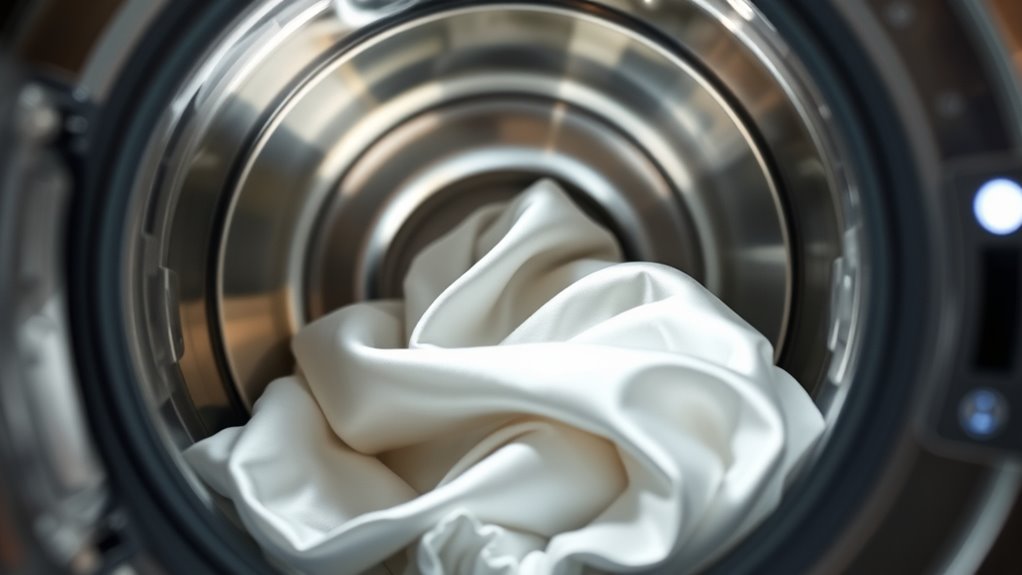When washing silk in your machine, always choose a gentle, dedicated cycle labeled “silk” or “delicate” to prevent damage. This cycle uses low agitation and cold or lukewarm water, which helps preserve the fabric’s softness and color. Avoid high-speed spin or heavy loads, and consider using a mesh laundry bag for extra protection. To discover more tips for safe silk washing, keep going to learn how to keep your silk looking its best.
Key Takeaways
- Use a delicate or silk-specific cycle to minimize agitation and protect fibers.
- Select cold or lukewarm water settings to prevent color fading and fiber damage.
- Always check the garment’s care label for specific washing instructions.
- Use a mesh laundry bag for extra protection against rough agitation.
- Avoid high-speed spin cycles; opt for gentle or no-spin options to prevent stretching.

Have you ever wondered how to wash silk without damaging its delicate fibers? If you’re considering using your washing machine, it’s essential to understand the right cycle setting to keep your silk garments looking their best. Many people overlook the importance of choosing the proper cycle, which can lead to unnecessary wear, color fading, or even tears. The key is to use a gentle, dedicated cycle designed for delicate fabrics, often labeled as “silk” or “delicate,” to ensure your garments are treated with care.
One critical aspect of washing silk in the machine is understanding drying techniques afterward. Silk is sensitive to heat and agitation, so air drying is generally the safest option. Lay your silk items flat on a clean, dry towel or hang them on a padded hanger away from direct sunlight to prevent fading. Avoid using a tumble dryer unless it has a no-heat or low-heat setting, as high temperatures can cause shrinkage or damage the fibers. If you must use a dryer, use a delicate or air-dry cycle with no heat, but always check your garment’s care label first.
Stain removal is another important factor. Before washing, gently treat any stains with a mild stain remover or a mixture of cold water and a gentle detergent. Do not rub harshly, as this can weaken the silk fibers and cause pilling or holes. Instead, dab softly from the outside of the stain inward, then let it soak briefly before washing. When you load your silk into the washing machine, keep the garments separate from rougher fabrics to prevent snags. Using a mesh laundry bag can offer extra protection during the wash cycle. Additionally, understanding the significance of contrast ratio can help you better appreciate how the visual quality of your silk items is affected by light and dark color combinations, especially in display or photography settings.
Frequently Asked Questions
Can I Wash Silk With Other Delicate Fabrics?
You can wash silk with other delicate fabrics if you choose the right cycle and detergent choices. Use a gentle, silk-safe detergent and avoid harsh chemicals. When stain removal techniques are needed, gently treat spots before washing to prevent damage. Always opt for a delicate or hand wash cycle, and place silk in a mesh bag for extra protection. This guarantees your fabrics stay soft, vibrant, and damage-free.
How Often Should I Wash Silk Items?
You should wash silk fabric items only when necessary, generally after 2-3 wears unless they get visibly dirty or stained. Frequent washing can damage delicate fibers, so follow the recommended washing frequency to keep your silk looking its best. Always opt for gentle cycles and cold water, and consider hand washing for extra care. This way, your silk stays soft, shiny, and beautiful longer.
Is Hand Washing Better Than Machine Washing Silk?
Did you know that 80% of silk damage occurs during machine washing? Hand washing benefits include gentler cleaning, preserving the delicate fibers, and reducing the risk of damage. Machine wash risks involve harsh agitation and high temperatures that can weaken silk. If you want your silk pieces to last longer, hand washing is the safer choice, especially with cold water and mild detergent. Always handle silk gently for best results.
What Temperature Is Safest for Silk in the Wash?
For silk, maintaining a safe temperature is key to preserve its silk dyeing and delicate fabric types. You should set your washing machine to cold or lukewarm water, around 30°C (86°F), to prevent damage. Hot water risks shrinking or fading the silk fabric types, especially those with vibrant dyeing. Always check the care label to confirm you’re using the right temperature, keeping your silk pieces looking their best longer.
Can Silk Be Dried in a Dryer Safely?
Imagine silk as delicate as a butterfly’s wing—you wouldn’t want to crush it. When it comes to silk drying, dryer safety is vital. You should avoid using a regular dryer, as high heat can damage the fabric. Instead, opt for air drying or a no-heat setting. This gentle approach preserves silk’s softness and shine, ensuring your garment stays beautiful and intact. Always prioritize gentle silk drying methods to extend its lifespan.
Conclusion
So, next time you toss silk into your washing machine, remember the gentle cycle is your secret garden of care. It’s like giving your delicate treasures a tender dance, preserving their silky whispers and shimmering grace. With this safe setting, you’re not just washing fabric—you’re nurturing a fragile piece of art. Treat your silk with kindness, and it’ll reward you with timeless elegance, whispering stories of grace for years to come.









